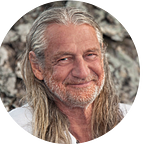“Spirit means breath, Sir! Nothing more.” Mark Whitwell on the Power of Yogic Breathing
Mark Whitwell | Heart of Yoga
Through careful observation of the breath, you can fine-tune your practice in a way that is conducive to your present life situation, ensuring that you move forward in a positive, intelligent manner.
The main thing is to enjoy the breath as your guide throughout the practice. Let the breath be your teacher. It is the key to creating a practice that is personal to you.
What is Yoga?
1| Consciously being attentive to the breath is the process which is Yoga. The ‘father of modern Yoga’ Tirumalai Krishnamacharya defined Yoga as:
Yoga is to direct consciousness via the mind in a direction of choice with continuity.
When we direct our attention in one direction without distraction we become absorbed into that object of our attention. In our daily practice, our object of focus is the breath.
By focusing on the breath during asana and pranayama our whole body/mind is given over to a single direction. As a result of going in our chosen direction with continuity, the mind’s fluctuations calm down and we know ourselves at a deep level.
It is not about controlling the mind. Rather, the mind calms down naturally when we know what we want and we go towards that with continuity.
My teacher would say that asana, pranayama, meditation, and life are a seamless process. If we can merge with the breath, we can also merge with our desired directions in life — including our relationships with others.
2| The breath is also the major means by which we are able to concentrate prana in our system (prana being our life force or essence). By cleansing and strengthening our system with the breath we eliminate blockages and so the prana (life energy) flows more easily in us.
3| The old yogis believed that our life span is measured not in years but in breaths. By becoming intimate with the breath and lengthening it, it is believed that the life span is extended.
Yoga: Downtown Exercise or Devotional Practice?
To have such a focus on the breath may sound quaint within the popular understanding of modern Yoga as a form of gymnastic exercise. Yet, the absence of the breath in the modern brands is the telling sign that a distortion of the tradition of Yoga has taken place.
For Yoga was never a form of exercise of physical struggle. Yoga arose in indigenous shamanic culture as the practical means by which each person could embrace the power and beauty of their Life, of Reality, of God, if you want to use that language. And the breath is the key ingredient that makes our practice our devotional embrace of Life rather than a sweaty workout.
My teacher U.G. was fond of pointing out that in Latin,
“Spirit means breath, Sir! Nothing more.”
This is because the source of life is felt as the breath. Each cycle of breath unites the strong masculine qualities of the exhalation with the receptive, feminine qualities of the inhalation. The whole body becomes permeated by its male and female qualities; the blissful absorption of one to another.
And the body loves its breath! The inhalation loves the exhalation. By carefully using the mechanics of the anatomy to move the breath, the whole system is restored to its natural state. The mutuality of male/female, strength that receives, is restored.
Yoga is your daily embrace of the nurturing source of life that is currently arising as your whole body. Through the unitary movement of body, breath, and mind, the mind gets linked to the whole body, which is reality itself. The mind relaxes into its source. We feel at peace.
Tirumalai Krishnamacharya
In this precious photo we see Tirumalai Krishnamacharya practicing asana. You can see there is no bravado in the asana, no vain athleticism or struggle to achieve an idealized posture. There is no deluded drama or cadence of superiority. No authority being played out.
In fact, there is a technical principle being demonstrated of equal strength to receptivity, a softness in the whole body as well as strength, enacted via the easeful inhalation merging with exhalation as the central feature of the asana with bandha. It is strength that is utterly receptive, which is real strength.
Participation in the union of inhalation with exhalation, strength with receptivity is in fact the main purpose of asana, not its exact look or notions of straight lines and angularity of alignment that have been branded into the modern Yoga mind.
When we published The Heart of Yoga: Developing a Personal Practice (1995) with photos of Krishnamacharya in asana, yoga students felt confused to see the softness and the absence of drama in his body. Some would even become critics claiming that his young student Iyengar had brought exactitude into asana.
The opposite is true. So much exacting technology of the wisdom tradition that Krishnamacharya brought forth has been left out of modern brands. They have been made dangerous as life practice with no knowledge of how to adapt Yoga to individual needs or to empower each person in the power and beauty that is their life. Yoga has been branded as a struggle toward a future perfection either in physical or mind gymnastics rather than participation in the given perfection that is your existence. This must be understood for Yoga to begin.
Heart of Yoga
Read More:
